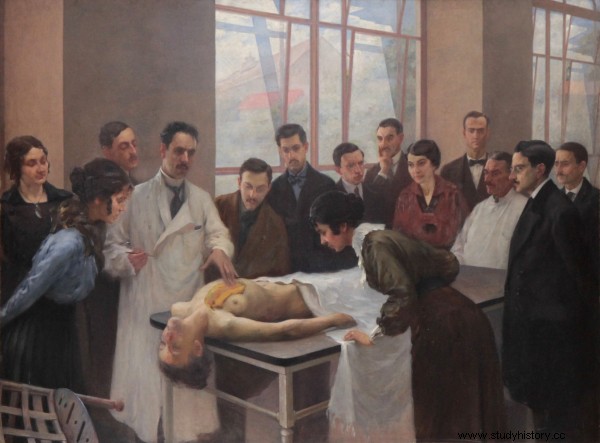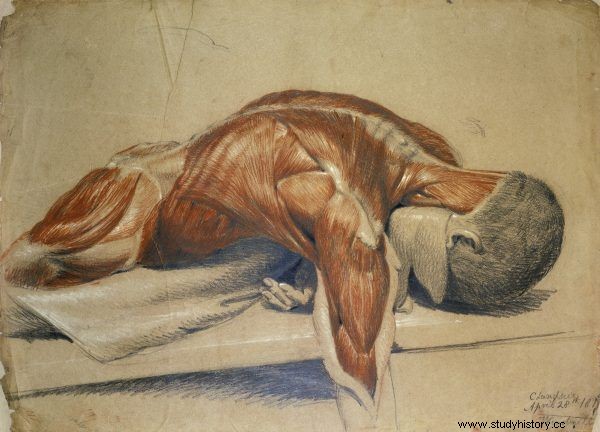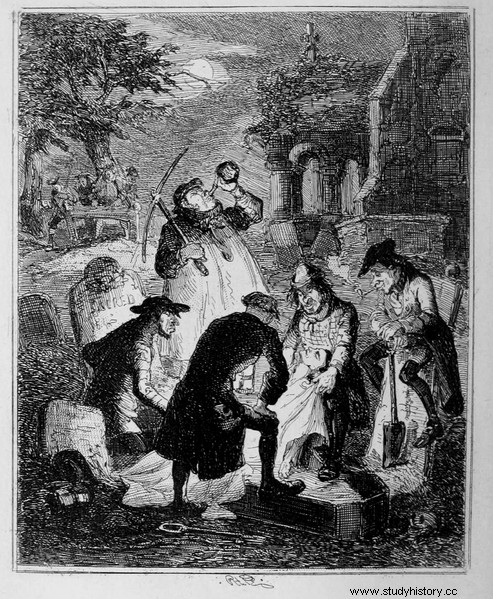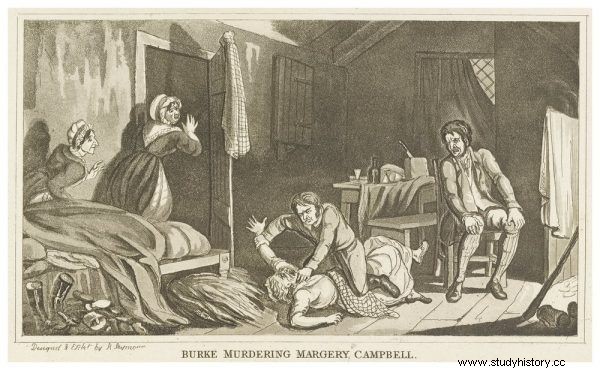strong> The eighteenth and nineteenth centuries were a period when the anatomy schools flourished in England. The number of facilities enabling medical students to educate and first practice on the bodies of the deceased has increased significantly. This sudden increase in schools was associated with an increased need for human corpses, and in spite of anger, the number of the dead did not suddenly increase, and what was worse, religious issues were also on the way ...
Law and religion against autopsies
Between the sixteenth century and the first half of the nineteenth century in Great Britain, according to the law, anatomists could only count on the corpses of murderers sentenced to death. The authorities even used this provision as a form of warning and deterrence from committing more serious offenses. When the criminal on his account had stolen farm animals, he "only" threatened to die by hanging, but when he killed his neighbor, apart from the noose, an autopsy was waiting for him. This form of British law was in force from 1752 and replaced the previous penalty of immersing the murderer's body in tar, and then placing it in a cage and displaying it on the market, where every citizen could watch the body of the villain rotting and torn apart by crows.

"The Master" - anatomy lesson
Contrary to appearances, such a system of punishments could deter some potential criminals, because the followers attending mass in English churches believed that the resurrection takes place while maintaining the former corporeality . They believed that the possibility of going to heaven in an incomplete or gutted body was unlikely.
And how do you deal with the cadaver deficit?
British anatomists, in order to save their schools from closing, began to bring the bodies of deceased relatives. Some medics were willing to make sacrifices and cut their own parents or siblings. The remaining fragments of the bodies of family members were buried in church cemeteries. However, the number of deceased close anatomists was too small to meet the educational needs of their institutions. A way had to be found that would enable them to deliver the dead on a constant basis.
During this time, the night time activity in cemeteries increased significantly which consisted in digging up graves for robbery purposes. However, the prey was not the valuables in the tombs of wealthy citizens, but corpses. A thief caught with jewelry that could be easily identified as belonging to the deceased ended up on the dock, but when he had only the body with him ... he did not bear any consequences of his act.
The doctors themselves encouraged their students to steal corpses from cemeteries and bring them to school internships. In fact, in some Scottish anatomy schools in the 18th century, it was strongly preferred to pay tuition fees in the form of dead bodies . Besides, the teachers themselves set an example for their pupils and they also delivered corpses for apprenticeships straight from the night cemetery expeditions. However, despite so much commitment from the medics and their students, there were still too few bodies.
New job
Anatomy teachers were willing to pay for the delivery of human bodies. They didn't care where they came from, the most important thing for them was that they could serve science.

Image by Charles Landseer shows the skinned man
By 1828 in London, ten "professionals" and about two hundred amateurs wishing to earn some extra money were hardly earned during the anatomy courses. The House of Commons in a report from 1828 presented the information that a gang of several people, the so-called three hundred and twelve graves desecrated the resurrecters . The removal of so many bodies paid a salary of about a thousand dollars a year, which was then five times the worker's salary. It should be remembered that between June and September there was a dead time, nomen omen, when these "workers" were off. Thanks to such attractive working conditions, many gravediggers preferred to change their profession and take care of kidnapping corpses from cemeteries.
In order to act quickly and efficiently, it was necessary to break a hole in the lid of the coffin to allow the deceased to be pulled out on a rope tightened around the neck or armpits. Material was spread around, on which soil was poured from the grave, and then quickly poured into the old place, so that the whole procedure did not take more than an hour.
An ethical approach of anatomists?
The resurrecters were above all unscrupulous people who were at odds with the law, for whom the highest value is the remuneration received. On the other side of this transaction, however, there were enlightened people, people of science. Did they take any social norms and work ethics into account?
It turns out that for anatomists the end justified the means. Even the most eminent surgeon of this period, Sir Astley Cooper, despite the official condemnation of this practice, employed resurrecters and urged his associates to kidnap the bodies . Dr. Cooper commissioned the retrieval of the fresh corpses of his former patients. Thanks to this, he was able to analyze the effect of his previous work. He also paid for the bodies of patients with atypical medical cases who were under the care of physicians they knew during their lifetime.

1887 Illustration of Resurrectors at Work
Anatomists using the services of resurrectionists considered this practice as morally justified as it served the development of science and the gaining of experience by medical practitioners.
The corpses have become so common a matter of trade that people did not pay attention to what and how they were transported. There were situations when crates or boxes were confused with completely different contents. As James Moores Ball describes in his book "The Sack-'Em-Up Men", one of the cases when to the anatomical laboratory instead of a corpse:
[a shipment containing] a very decent ham, a large chunk of cheese, a basket of eggs and a huge bale of cotton.
It is a pity that we do not know the reaction of the recipient of the box, who, instead of his usual order, found a human body ...
The fate of the remains of the anatomy lesson
The anatomists wanted to get rid of the problem of the remaining remains that were no longer useful for apprenticeship, so no attention was paid to the way they were hidden. Everything was done in a rush, the body was buried shallowly, most often in the back of the building. As it was not difficult to guess, the stench from makeshift graves was a common problem. Hence, there have been many rumors that the teachers of anatomy schools used various methods to eliminate this problem. Some were to act in consultation with the owners of predatory animals by feeding them with the carcasses, while others were to use human remains to prepare soap and candles.
Funeral directors, in order to meet the expectations of their clients who want to protect the bodies of their loved ones or their own, have prepared a number of products and services. Of course, the whole range of posthumous security options was aimed only at people with a thick wallet, and among the most demanding were ... the anatomists themselves. There were coffins in a double and triple version, as well as with a system of locks and gears , special latches or steel belts to prevent the removal of the deceased. Scottish churches offered the possibility of keeping the corpses in special buildings until the corpses were decomposed so advanced that they would not be fit for scientific purposes.
Kills approval
Scottish anatomist Robert Knox went one step further than using resurrectors. He did not mind that the corpses he received from William Burke and William Hare clearly indicated that they were completely fresh bodies and that the deaths of the dead were not of natural causes. For example, one had a foot and a head removed, and another had traces of blood from the ears or nose.

Illustration of the recent murder of William Burke by Margery Campbell
William Burke, who ran a boarding house in a Edinburgh slum with his wife, found that with little effort he could make some extra money. Burke overpowered a guest of his guesthouse and Hare defeated the victim with a pillow. They sold several bodies to scientist Robert Knox.
When the case was revealed, Burke was sentenced to death and his body was put into an autopsy. The court also decided that, following an anatomy lesson, Burke's remains were donated to the Royal Academy of Surgeons in Edinburgh. The local medics prepared a skeleton, and wallets were made of leather, and the effect of their work can be admired in the academy to this day . William Hare was released and Robert Knox did not face any formal consequences.
At the same time, there was a debate in the House of Commons that the anatomy of the British had no control. Other possibilities of obtaining the corpse for scientific research were sought, including from hospitals or shelters, and the abandonment of dissection in favor of learning anatomy on the basis of already prepared exhibits from the human body, sketches or models was considered.
Bibliography:
- Bailey J.B., The Diary of a Resurrectionist, London 1896
- Ball J.M., The Sack-’Em-Up Men:An Account of the Rise and Fall of the Modern Resurrectionists, London and Edinburgh 1928
- Cole H., Things for the Surgeon:A History of Resurrection Men, London 1964
